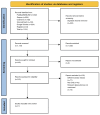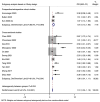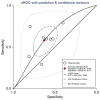Association between lipid accumulation product index and chronic kidney disease: A systematic review and meta-analysis
- PMID: 38873040
- PMCID: PMC11170318
- DOI: 10.3892/etm.2024.12597
Association between lipid accumulation product index and chronic kidney disease: A systematic review and meta-analysis
Abstract
Diabetes mellitus and lipid metabolism disorders are increasingly recognized as key contributors to the development of chronic kidney disease (CKD). The lipid accumulation product (LAP) index, a novel marker of lipid accumulation, has potential implications for CKD risk assessment. The present meta-analysis aimed to assess the association between LAP index and CKD, with an emphasis on varying impacts in diabetic and non-diabetic populations. A comprehensive search for relevant publications was performed using PubMed/MEDLINE, Scopus, Cochrane Library, ScienceDirect and Google Scholar databases, and a meta-analysis of 17 studies was performed to investigate the relationship between LAP index and CKD. The random-effects inverse-variance model employing the DerSimonian-Laird estimator for τ² was utilized to calculate pooled odds ratios (ORs). Diagnostic accuracy was assessed using summary receiver operating characteristic (ROC) curves, with calculations of the area under the ROC curve (AUROC), sensitivity, specificity, likelihood ratios and diagnostic OR. The pooled OR for the association between higher quintiles or tertiles of LAP index and CKD was 1.098 (95% CI: 1.043-1.152), with substantial heterogeneity (I²=91.2%) and evidence of publication bias. Subgroup analysis revealed a stronger association in non-diabetic (OR=2.422, 95% CI: 1.802-3.042) compared with diabetic patients (OR=1.018, 95% CI: 0.993-1.043). The diagnostic accuracy of LAP index for CKD was moderate (AUROC=0.64), with sensitivity and specificity estimates of 0.58 and 0.63, respectively. In conclusion, in the present study, LAP index demonstrated a modest but significant association with CKD, particularly in non-diabetic patients. Despite its moderate diagnostic accuracy, the LAP index could serve as a valuable tool in CKD risk stratification, particularly when integrated with other clinical markers.
Keywords: chronic kidney disease; lipid accumulation product; meta-analysis.
Copyright: © 2024 Wu et al.
Conflict of interest statement
The authors declare that they have no competing interests.
Figures





Similar articles
-
Prognostic nutritional index as a predictive marker for acute kidney injury in adult critical illness population: a systematic review and diagnostic test accuracy meta-analysis.J Intensive Care. 2024 Apr 26;12(1):16. doi: 10.1186/s40560-024-00729-z. J Intensive Care. 2024. PMID: 38671543 Free PMC article.
-
Composite lipid indices in patients with obstructive sleep apnea: a systematic review and meta-analysis.Lipids Health Dis. 2023 Jun 29;22(1):84. doi: 10.1186/s12944-023-01859-3. Lipids Health Dis. 2023. PMID: 37386562 Free PMC article.
-
Association of lipid accumulation product with chronic kidney disease in Chinese community adults: a report from the REACTION study.Lipids Health Dis. 2021 Oct 9;20(1):131. doi: 10.1186/s12944-021-01569-8. Lipids Health Dis. 2021. PMID: 34627270 Free PMC article.
-
Burden and Determinants of Chronic Kidney Disease Among Diabetic Patients in Ethiopia: A Systematic Review and Meta-Analysis.Public Health Rev. 2021 Apr 9;42:1603969. doi: 10.3389/phrs.2021.1603969. eCollection 2021. Public Health Rev. 2021. PMID: 34692175 Free PMC article. Review.
-
Association Between the Surrogate Markers of Insulin Resistance and Chronic Kidney Disease in Chinese Hypertensive Patients.Front Med (Lausanne). 2022 Feb 7;9:831648. doi: 10.3389/fmed.2022.831648. eCollection 2022. Front Med (Lausanne). 2022. PMID: 35198578 Free PMC article.
References
-
- Khanmohammadi S, Tavolinejad H, Aminorroaya A, Rezaie Y, Ashraf H, Vasheghani-Farahani A. Association of lipid accumulation product with type 2 diabetes mellitus, hypertension, and mortality: A systematic review and meta-analysis. J Diabetes Metab Disord. 2022;21:1943–1973. doi: 10.1007/s40200-022-01114-z. - DOI - PMC - PubMed
LinkOut - more resources
Full Text Sources
Research Materials
